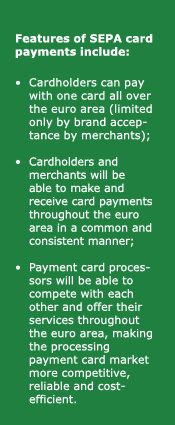SEPA strives to ease electronic payments across European Union
 Now that the euro is firmly entrenched, the next big step for euro-using countries is SEPA, an initiative designed to make electronic payments easier from country to country.
Now that the euro is firmly entrenched, the next big step for euro-using countries is SEPA, an initiative designed to make electronic payments easier from country to country.
When Europeans began migrating to the euro in 1999, the goal was a single payment vehicle usable in all euro-accepting countries. That meant the same currency in Germany was also acceptable in France. Forgotten–at least initially–was what to do with non-cash payments, those made with credit/debit cards.
Such payments between two countries can be expensive and complicated. Attempting to fix this, the European Union in December 2001 began requiring banks to charge the same fees for cross-border and national payments. But the costs for processing cross-border payments were high and the new rule meant banks could not pass these costs on to their customers. That led to the creation in 2002 of the European Payments Council (EPC), an organization tasked with building a single euro payment area. SEPA was born.
EPC’s purpose is to create of SEPA “a single harmonized, open and interoperable European domestic payments market…through industry self-regulation.” The organization now consists of 65 European banks, including three European credit sector associations and the Euro Banking Association.
SEPA’s charter reads:
- “We, the European banks and European Credit Sector Associations:
- share the common vision that Euroland payments are domestic payments,
- join forces to implement this vision for the benefit of European customers, industry and banks and accordingly,
- launch our Single Payments Area.”
Why SEPA? Currently, the euro area economy is unable to fully exploit the benefits of a monetary union. Customers face difficulties when making euro retail payments in other euro area countries, as these payments often turn out to be more time-consuming. As long as this is the case, the euro cannot be viewed as a fully implemented single currency. As one EPC release put it: SEPA is meant to “turn the fragmented national markets for euro payments into a single domestic one.”
Once SEPA is fully realized, citizens and industry will “be able to make payments as easily and inexpensively as in their hometown.” National boundaries won’t matter.
The best description of SEPA–its plans and goals–is included in a 32-page document released last year by the European Central Bank entitled: “The Single Euro Payments Area (SEPA): An Integrated Retail Payments Market.”
According to that document, SEPA, when operational, will consist of a single set of euro payment instruments (credit transfers, direct debits and card payments), an efficient processing infrastructure for euro payments, common technical standards, common business practices, a “harmonized” legal framework and development of new customer-oriented services.
To succeed, it must include interactions between the European banking industry (responsible for restructuring the payment systems in the euro areas), the European clearing and settlement industry, and euro area companies.
Critical to SEPA are the infrastructure providers, such as the card processors and the European Automated Clearing House Association (EACHA), which is developing a set of procedures to secure interoperability. It has also led to the creation of the first pan-European automated clearing house, nicknamed PEACH, for clearing both cross-border and domestic retail euro payments.
 Benefits reach consumers, merchants, and companies
Benefits reach consumers, merchants, and companies
Once SEPA is fully established by 2010, consumers will only need one bank account. From this account, they will be able to make euro credit transfers and direct debit payments anywhere in the euro area.
For merchants, SEPA offers several advantages. For example, acquirers will be able to process all SEPA-compliant card payments, even across borders. In the SEPA environment, merchants will be able to choose any acquirer in the euro area to process their card payments. This will increase competition and supposedly drive down costs. With the standardization of POS terminals, merchants will also have a wider choice of terminal providers and they’ll be able to accept a wider range of cards from a single terminal.
For companies, SEPA will simplify payment management. They’ll be able to perform all of their euro-denominated financial transactions centrally from one bank account, using SEPA payment instruments. All incoming and outgoing payments will use the same format. By consolidating their payment and liquidity management in one location, euro-accepting companies will save time and money. Utilizing e-invoicing and e-reconciliation, companies can further optimize their handling of payments. Today, these services are often only offered nationally, as different payment formats make cross-border use difficult.
By providing new payment instruments and euro area-wide infrastructures, SEPA will help banks expand their business by competing on a euro area level. In other words, any bank will be able to offer its services to any individual in the euro area. Further, European integration and market efficiency will ensue because there will be a single set of rules, equal and open access, reachability, transparency and interoperability.
New payment schemes to replace national processes
The EPC has defined two new payment schemes – the SEPA credit transfer and SEPA direct debit schemes–that will gradually replace current national instruments.
The SEPA credit transfer (SCT) is an interbank payment scheme that defines a common set of rules and processes for euro-based credit transfers. It defines a common service level and a time frame under which participating financial institutions must conduct SCTs.
The SEPA direct debit (SDD) is an interbank payment scheme that defines a common set of rules and processes for direct euro-based debits. It defines a common service level and a time frame for participating financial institutions.
SEPA card payments will take place according to principles which issuers, acquirers, and operators will have to adapt to.
 Challenges still exist
Challenges still exist
The EPC probably summed SEPA up best when it referred to it as “the largest payments initiative ever undertaken within Europe. Governments, public authorities, merchants, corporations, trade and consumer bodies and the payments supplier sector all have roles to play in making the project as successful as the implementation of the euro.”
A number of concerns were expressed in July when the European Central Bank, representing euro-using countries (Eurosystem) issued its fifth SEPA progress report, “Single Euro Payments Area, From Concept to Reality,” in July.
The report notes that SEPA has “entered into a critical phase” with the official launch in January, 2008 just months away. It sees “gaps” representing either short-term problems “that could hamper the timely start of SEPA” or longer-term problems “that could have a negative impact on the continued success of SEPA.” The areas that need the “most attention” are related to “card schemes and card payments, direct debits, as well as the awareness and preparedness of all stakeholders.”
The report lists 12 concerns that need to be addressed. For example, there is still some confusion over what SEPA is expected to accomplish, particularly in regard to direct debits. “The EPC needs urgently to clarify the exact features of all elements that will be offered in addition to the core SEPA direct debits by December 2007. In this respect, it is of paramount importance that the SEPA direct debits are both simple and safe to use and do not present a deterioration in comparison with current service levels, so that customers will choose to use them…”
A second concern regards “card standardization. Defining card standards “is crucial in order to achieve full interoperability between all parties involved in the processing of card payments (including merchants and processors), as well as to create more competition and to facilitate the emergence of additional European debit card schemes,” the report adds.
Third, the Eurosystem would like to see “at least one additional European debit card scheme…which could be used mainly in the euro area countries. Such a scheme would stimulate competition and would ensure the close involvement of European banks…”
Another concern is what the Eurosystem calls “reachability. It is crucial for the successful launch of SEPA that those banks whose payment volumes represent the critical mass of payments are able to send and to receive SEPA credit transfers” beginning next January. Smaller banks should initially “be capable” of receiving SEPA credit transfers when SEPA begins its early launch phase in January and “be capable of sending them in the course of 2008.”
Some of the other concerns/suggestions mentioned in the progress report include:
- More involvement of non-bank stakeholders is needed. “The Eurosystem encourages the EPC, in cooperation with national migration bodies, to strengthen the involvement of, in particular, public administrations, corporate enterprises and merchants so as to ensure their readiness for SEPA by January 2008.”
- Eventually, SEPA needs to be broadened to include “payment innovation, such as e-payments for internet retailers, e-mandates for direct debits and new payment schemes, such as a priority credit transfer scheme.”
- The security of SEPA payment instruments needs “to receive more attention. The Eurosystem would like to reiterate the urgent need for work on the security of payments, especially in the field of Internet banking, card payments via the internet and e-payments. The EPC has taken primarily inter-bank security into account, but has not specified end-to-end security issues…The EPC is therefore requested to undertake a threat assessment encompassing the complete end-to-end process, to develop a set of best practices and to promote the use of these practices by the banks.”
- “Implementation and migration plans should be publicly available.” It notes that these plans, which “should be concrete and precise and … provide guidance to all stakeholders” must be published by the end of this year.
- Along the same lines, more communication about SEPA is needed. Those who will be participating in SEPA should be made aware of the initiative’s “long-term goals, challenges and benefits.” The key target groups, it notes, are corporations and public bodies “in their function as large users of payment services” on one side and small and medium-sized companies and consumers, all representing the smaller users, on the other. “In particular, banks should present their actual service offerings, so that their customers know what to expect from SEPA.”



